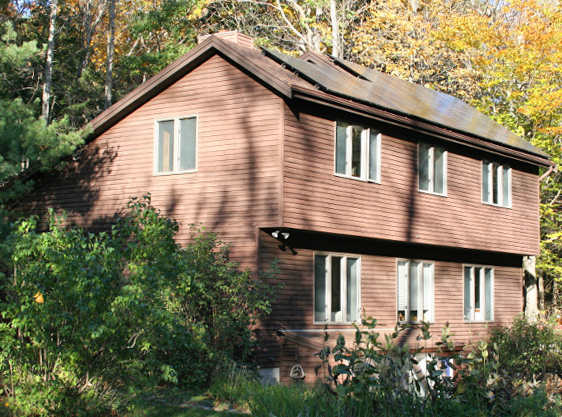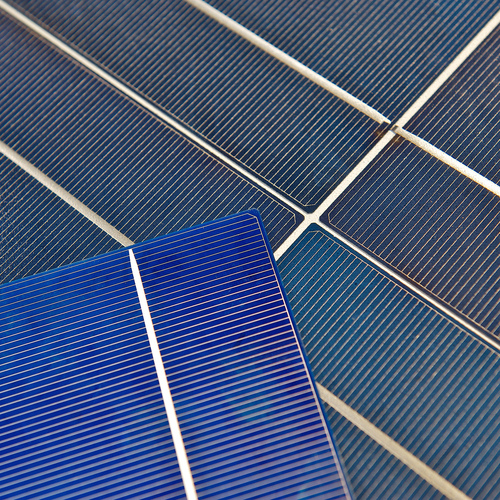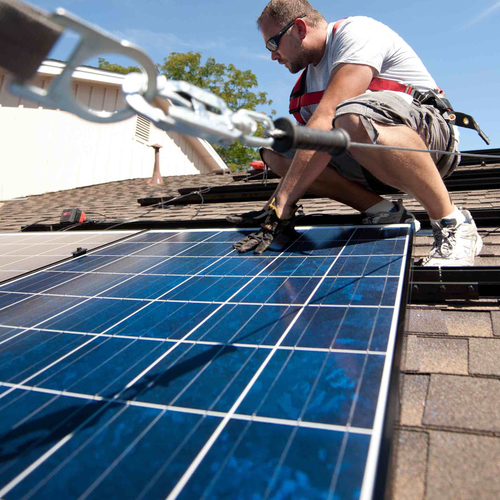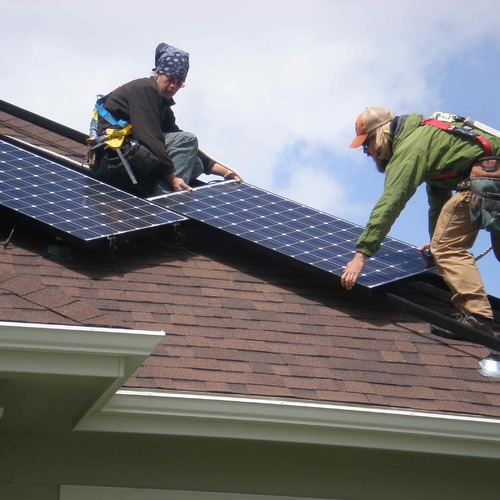
Image Credit: Images #1 and #2: Israel Yost
Image Credit: Images #1 and #2: Israel Yost This is a closeup of my brother’s PV panels after 3 or 4 days of no rain in June, near the height of the pollen production season for his area. A web site called Weather Underground (www.weatherunderground.com) provides pollen assessment by type — tree, grass, or weed — and even species. This graph is from “Effect of dust pollutant type on photovoltaic performance,” published in Renewable and Sustainable Energy Reviews, volume 41, 2015.
Image Credit: Image #3: Renewable and Sustainable Energy Reviews This photo was published in an NREL report, “Best Practices in Photovoltaic Systems Operation and Maintenance,” 2nd edition.
Image Credit: Image #4: NREL This is a reproduction of an image from page 25 of a DOE Office of Indian Energy report, “The 5-Step Development Process; Step 5: Project Operations and Maintenance.”
Image Credit: Image #5: U.S. Department of Energy These Sunbrush brand tractor-mounted brushes are used to clean the solar panels of a 200 MW solar installation in Seih Al-Dahal, Dubai.
Image Credit: Image #6: Sunbrush Mobil GmbH Ecovacs Robotics recently introduced the Raybot, a waterless solar panel cleaning robot.
Image Credit: Image #7: Ecovacs Robotics Under the Solmaks brand, a company called Integra Global makes a range of panel-cleaning systems, including this rack-mounted device.
Image Credit: Image #8: Integra Global This worker in India is using the “elbow-grease” panel cleaning system.
Image Credit: Image #9: Global Sustainable Energy Systems, India
I was at my brother’s house in Lee, New Hampshire, recently and looked up to see that his photovoltaic (PV) panels looked a bit dull (see Image #2 below). His PV array is easy to get to — the long north slope of his roof has a walkable 5:12 pitch — so we went up and took a closer look.
It turns out that the PV industry calls the accumulation of dirt on a PV panel “soiling” or “fouling.” And maybe I should have stopped researching this issue when our own expert PV practitioner, Martin Holladay, told me: “I’ve read that the value of the increased electricity resulting from washing PV modules is too low to justify the cost of the labor required for the washing, except in desert areas of India, where labor is cheap, winds are dusty, and rain is infrequent. It’s certainly true that in Vermont, rain and snow take care of this issue. In 38 years, I’ve never washed a PV module.”
But I just could not resist digging a bit deeper.
Do PV companies factor in anything for soiling when predicting PV output?
“Yes,” says Travis Genatossio, operations manager for ReVision Energy, the PV company that installed my brother’s system. “We use a modeling program called HelioScope that includes both soiling from pollen and dust as well as snow coverage. But we typically only run HelioScope for large commercial PV installations, not small residential systems.”
This resource from Folsom Labs, the software company which developed HelioScope, states that soiling effects are a “user-defined input.” Canute Haroldson of Folsom Labs said, “Soiling is a user-defined input because it is not monitored using a universal monitoring system, so it cannot be automatically assigned. In addition, it depends on an extremely high number of variables that represent factors that cannot be monitored. Due to these conditions, soiling remains a user-defined input in HelioScope as that is the most accurate way to model it currently.”
ReVision Energy has offered to run their HelioScope model for my brother’s PV array, but they haven’t completed the computer run yet. I will post the HelioScope results to this blog when we get them and particularly what they decided to use for annual soiling losses and why.
Has anyone ever collected field data on soiling?
This took some real digging, but yes, the Sacramento Municipal Utility District (SMUD) as well as researchers from the University of California-San Diego found representative annual PV output losses of approximately 7% due to soiling. (See the NREL report, “Best Practices in Photovoltaic Systems Operation and Maintenance.”) Since the studied sites were all in the West, ranging from San Francisco Bay to the U.S.-Mexican border, areas with more precipitation would most certainly have even lower typical annual losses.
One international study — “Effect of Dust Pollutant Type on Photovoltaic Performance” (published in Renewable and Sustainable Energy Reviews, volume 41, 2015) — showed that the type of dust can make a big difference in soiling impacts (see Image #3 below). And the NREL report cited above identified bird droppings as particularly problematic because rain does not clean this material from panels (see Image #4).
When might it be worth cleaning?
It is no big surprise that the size of the array and its location figure significantly into whether or not cleaning is worth the effort. For a multi-megawatt PV installation, it can be worth cleaning the panels for a 7% increase in output. And ground-mounted arrays (the typical type of array used for most large PV installations) can be much easier to clean than roof-mounted ones.
A bar graph and list of bullet points from a DOE Office of Indian Energy report, “The 5-Step Development Process; Step 5: Project Operations and Maintenance” (see Image #5), gives tips on optimizing cleaning schedules for large ground-mount arrays.
How do you clean big arrays efficiently? There is no shortage of approaches: tractor-mounted cleaning arms (see Image #6), robot vacuums (see Image #7), track-mounted cleaning racks (see Image #8), and good old elbow grease (see Image #9).
Research is being conducted on coatings or electrostatic charges that will keep PV panels clear of most types of dust. (For more information, see a 2017 article, “Reducing dust effects on photovoltaic panels by hydrophobic coating,” published in Clean Tech Environmental Policy, volume 19, pages 577-585). But none of these coatings that I found were ready for prime time.
Final word
I was tempted to give Martin the final rather than the “starting” word on this, but I get the final word this time.
If you have a ground-mount or easy-to-access rooftop PV array and long periods without rain, you should think of PV panel cleaning as way more important than washing your car — but maybe less important than watering your garden.
If you have a large PV array that sees a significant steady source of soiling (such as bird droppings, nearby dusty roads, etc.), you should look to panel cleaning for increased output.
For all other situations, how you prioritize PV panel cleaning is likely to be correlated with how nice your car is, or how fastidious you are in general.
In addition to acting as GBA’s technical director, Peter Yost is the Vice President for Technical Services at BuildingGreen in Brattleboro, Vermont. He has been building, researching, teaching, writing, and consulting on high-performance homes for more than twenty years. An experienced trainer and consultant, he’s been recognized as NAHB Educator of the Year. Do you have a building science puzzle? Contact Pete here. You can also sign up for BuildingGreen’s email newsletter to get a free report on insulation, as well as regular posts from Peter.
Weekly Newsletter
Get building science and energy efficiency advice, plus special offers, in your inbox.















8 Comments
Degradation due to UV?
I rarely see (have never seen) any article mention the degradation in PV output over time due to exposure to UV. On the satellites I used to design in a prior life, 12-14 years was about it. After this you would hit the "knee" of the output vs. time curve and total output would start to fall quite quickly.
Now of course space has no atmospheric attenuation of solar energy, so things on earth won't be as bad.
But it surprises me how many folks have no idea that solar panels do have a limited lifespan.
Response to Gustave Stroes
Gustave,
You might want to read my article on this topic: "Testing a Thirty-Year-Old Photovoltaic Module."
In just two years, it will be time to take my 1980 module off the roof again for its 40-year check-up.
How hard is it?
The presumption is that cleaning PV panels is labor intensive with little benefit. That presumption is correct, on average. But then again, the average American is dead. The average living homeowner doesn't have any PV. Like most things, the specifics of one's own situation, or even for the average GBA reader, may diverge strongly from a national average, and getting some useful guidance for non-average situations is what Green Building Advisor is all about. It would be great if GBA could provide some figures on a few divergent, but common scenarios. My installer said that cleaning my panels might yield 10-15% improvement in output. Perhaps this is true in my arid climate, where rain-washing is a rare event.
The homeowner has an easier time judging the labor time needed in her/his not-in-India location. For ground mounted residential installations, cleaning the PV panels may be a five minute job with a garden hose. I've got three dual-axis trackers, so it takes me ten minutes to clean my 10 kW of PV panels, again using a hose. I enjoy doing it, from time to time.
Response to Derek Roff
Derek,
Peter Yost may not have made his opinions clear, but I'm happy to provide mine. Use old-fashioned common sense.
How can you tell if your panels are dirty? Look at them.
How can you tell how easy it is to wash your panels? Wash them once and decide.
Is the estimate of 15% degradation in output credible? Probably not, since estimates in dry, dusty California come in at 7% for dirty panels.
You're using common sense, Derek, so you're OK. You also found an easy way to wash your array with a garden hose. All is good with the world.
The answer isn't as trivial as it might seem
I agree with the value of common sense, and that includes trying to find out the relevant data and details that affect different cases. The NREL paper that Peter cites on PV output reduction due to panel soiling says:
"In an area with heavy agricultural activity 0.36%/day is reported, and contrasted to a rate of 0.01%/day in a desert area void of agricultural, construction, or industrial activity. Large bird populations may result in losses accumulating as high as 0.5%/day and dust storms in places like India have reported losses accumulating at around 1.5%/day."
So the range from the low to the high figures given in the study is a factor of 150 times. Agricultural activity is moderate where I live, and a factor not mentioned is the effect of cars driving on dirt roads, which generates a lot of dust in many rural areas like mine. If we take the 0.36%/day figure, panels could reach a 15% reduction in output within 15 days.
This contrasts strongly with the Phys.org article, which claims "The survey's findings are applicable more widely, Kleissl said. Pollution and dust levels in California are fairly representative of the rest of the United States." https://phys.org/news/2013-07-solar-panels-worth.html (the link is shown in photo 5 on this GBA page).
I'd like to read the Sacramento Municipal Utility District (SMUD) and University of California-San Diego studies that Peter mentions, but they aren't cited in the NREL paper that he linked, nor on the Phys.org page.
Common sense would suggest that when one researcher says reduction due to soiling varies by 150 times, and another says that the averages for California apply to the whole country, the problem may not be as trivial as it first appears. A given GBA reader may find that their site is quite different from the stated 7% average.
Cleaning
Perhaps the solution is already out there. Window washing for most homes and commercial buildings has gone to the water fed pole system. Ultra purified water is a powerful solvent and what used to take hours and elbow grease now takes minutes and technology. In areas that do not have high risk for soiling you could have a window washer come out and wash your windows and pv array once a year. In areas that are prone to high soiling purchasing your own system could cost $600 in soft water areas to $1600 in hard water areas. Not cheap but your windows and car would always be clean.
Response to David Kellers
David,
I think that for most homeowners with a PV array, the question isn't really "How do I remove dust from my panels?" After all, most people know how to wash their windows or wash their car.
The question is, "Is it worth it?" Most homeowners can figure that out pretty easily, I think, depending on how easy it is to spray their array with a garden hose or get up on their roof with a long-handled squeegee, and how busy they are.
If your PV array produces $300 or $400 worth of electricity a year, you're probably not going to buy $1,600 of equipment to clean your panels.
Solar Collector cleaning well worth the cost and effort!
We have a 10 Kwh, 36 panel Solar City collector bank on our single-storey, ranch-style home's 4:12 front roof, facing due South. Periodic cleaning, 2-3X/yr, improves our power generation by 10%. It takes about 1 1/2 - 2 hours for the whole process, from diluting the solution 1:2 in water, wetting the glass, washing, rinsing, clean-up.
Washing material costs (total about $90.) were as follows:
a.) Mr. LongArm 0404 Flow-Thru Regular Very Soft Polyester Cleaning Brush $19.52
b.) Mr. LongArm 8512 Hydrasoar Flow-Thru Extension Pole, 6-to-12 Foot $41.68 (both from AMZN)
c.) Winsol Solar Brite Panel Cleaning Solution $26.00/gal (5-6 washes) available directly from WINSOL Labs, 1417 NW 51st St., Seattle, WA 98107, 800-782-5501
website:
https://www.winsol.com/store/p17/Solar_Brite_-_Solar_Panel_Cleaning_Formula.html
data sheet:
https://www.winsol.com/uploads/4/2/3/1/42312731/6449_6450_-_solar_brite_-_sds_030116.pdf
The improved power generation seems to be well worth the effort and the collector bank looks a lot more attractive when clean, as well!
Log in or create an account to post a comment.
Sign up Log in